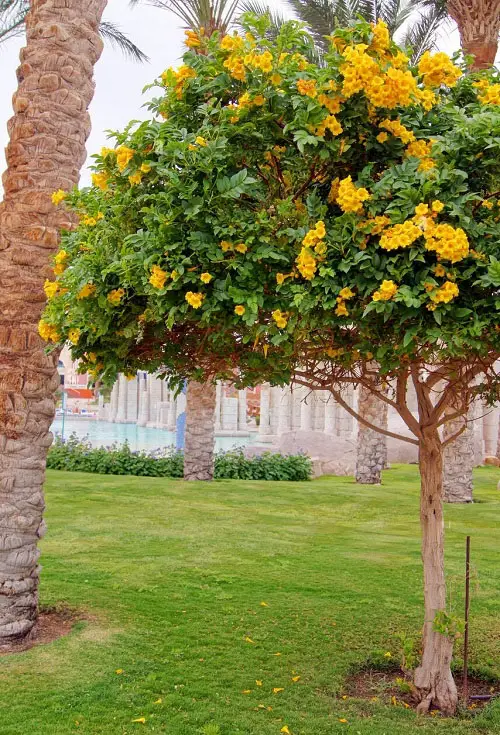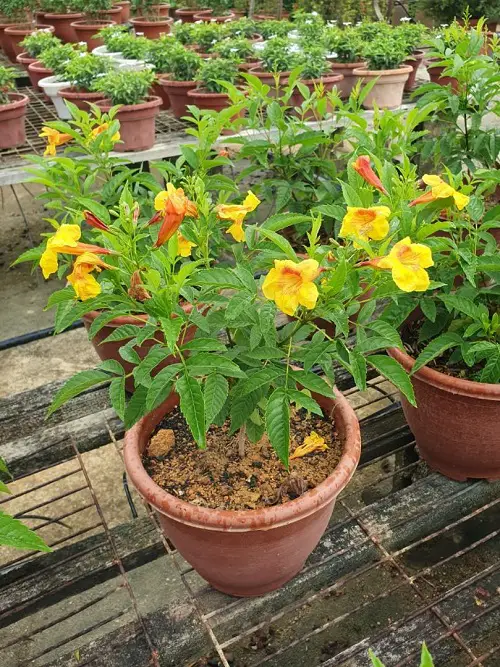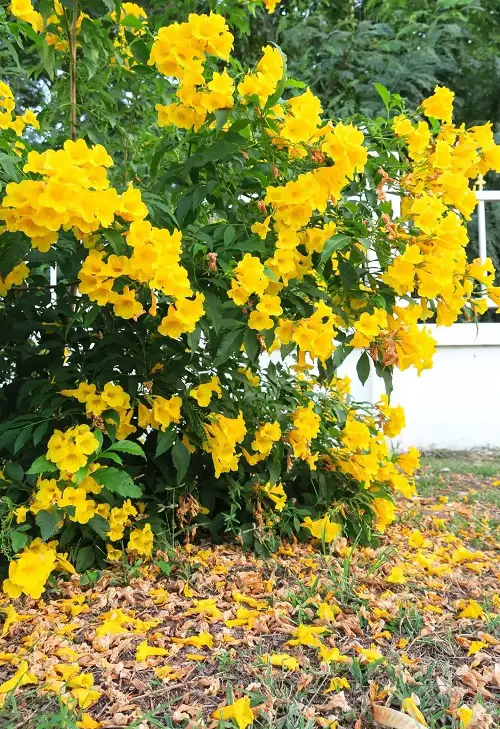If you are a fan of bright yellow flowers, then do not miss growing Esperanza Plant! Here are all the details to help you out!
Whether you’re a seasoned gardener or a beginner, this comprehensive guide will provide you with all the knowledge you need to grow and maintain the Esperanza Plant.
Esperanza Plant Information
The Esperanza Plant (Tecoma stans) is a tropical native that is commonly referred to by various names such as Yellow Bells, Hardy Yellow Trumpet, or Yellow Alder. It boasts distinct characteristics, with its dark green foliage serving as a backdrop to large clusters of lightly scented, golden-yellow, trumpet-shaped flowers.
These vibrant blooms grace the plant from spring to fall, adding a touch of beauty to any landscape. While Esperanza Plants are primarily grown for their ornamental appeal as shrubs or container plants, they have a historical significance as well.
In the past, they were widely recognized for their medicinal properties and even utilized in the production of root-based beer.
Botanical Name: Tecoma stans, syn. Tecoma alata
Common Names: Esperanza, Trumpet Flower, Yellow Trumpetbush, Yellow Bells, Yellow Elder, Tecoma Plant, Ginger-Thomas, and Yellow Bignonia
USDA Zones: 9-11
Learn How to Grow Kaleidoscope abelia here
Propagating Esperanza Plant
Propagating Esperanza Plant, can be done using stem cuttings and seeds. Using cuttings is the easiest way to do it.
- Select a healthy, mature stem from the Esperanza Plant. Look for a non-flowering stem that is about 4-6 inches long.
- Using clean and sharp pruning shears, make a clean cut just below a leaf node (where a leaf is attached to the stem).
- Remove the lower leaves, leaving only a few sets of leaves at the top.
- Optional: You can dip the cut end in a rooting hormone powder or gel to promote root development.
- Prepare a pot or container with well-draining soil or a mixture of perlite and peat moss.
- Make a hole in the soil with a pencil or your finger and gently insert the cutting, burying the bottom nodes.
- Water the cutting lightly and place it in a warm, bright location with indirect sunlight.
- After a few weeks, you should start to see new growth, indicating that roots are forming. Once the roots have been established, you can transplant the new Esperanza Plant into a larger pot or directly into the garden.
Requirements for Growing Esperanza Plant
Location
Choose a location that receives full sun (At least 6-7 hours) for growing Esperanza Plants. While the plants can tolerate some shade, it’s important to note that they may become leggy and produce fewer flowers when exposed to less light.
Soil
Esperanza Plants can handle a variety of soil types, including sandy, rocky, limestone, or loamy soil, as long as it is well-drained.
To create an optimal potting mix for Esperanza Plant, start with good-quality all-purpose potting soil. Combine it with a ratio of 2 parts potting soil, 1 part coarse sand, and 1 part peat moss.
Find out some Helpful Hacks to Improve Your Garden Soil for Free here
This well-balanced blend of ingredients ensures excellent drainage, promotes healthy root development, and enhances moisture retention in the soil.
Water
Esperanza Plants are drought-tolerant once established but benefit from moderate water. Water the plant when the top inch of the soil feels dry. Avoid overwatering, as it can lead to root rot and other issues.
Read about Rose of Jericho Uses and Benefits here
Esperanza Plant Care

Fertilizer
For Esperanza Plants, use a balanced liquid feed, diluted to half of its strength, once in 5-7 weeks. Adding a layer of compost as mulch in spring around the base of the plant is beneficial.
Here are Effective Homemade Lawn Fertilizers That Are Safe From Hazardous Chemicals
Pruning
Esperanza Plants primarily bloom on new wood and generally require minimal pruning. Light shaping can be done after the peak bloom period, typically from fall to late winter.
Dead or diseased branches can be removed at any time throughout the year. Depending on preference, Esperanza can be maintained as a shrub or trained into a small tree.
In the event of a hard freeze causing dieback, cutting the plants back to the ground is recommended.
Deadheading
Look for flowers that have faded, wilted, or lost their vibrant color. These are the flowers that are ready to be deadheaded. Using clean and sharp pruning shears or scissors, cut off the faded flower heads just above a leaf node or a lateral branch. Make the cut at a 45-degree angle to promote healing and prevent water from pooling on the stem.
After deadheading, closely monitor Esperanza Plant for new growth and the formation of new flower buds. Removing spent flowers encourages the plant to redirect its energy toward producing new blooms.
Pests and Diseases
Esperanza plants can still be susceptible to aphids, which can infest the plant’s leaves and stems, sucking sap and causing damage. Aphids can be controlled by regular inspection and the application of insecticidal soap or a strong stream of water to dislodge them.
While not a major problem for Esperanza plants, whiteflies can be controlled with insecticidal soap or yellow sticky traps.
Learn about Using Apple Cider Vinegar for Pests here
One of the potential diseases that can affect Esperanza plants is root rot. Ensure proper soil drainage and avoid overwatering the plant.
Additionally, Esperanza plants can occasionally be susceptible to leaf spot diseases caused by fungal pathogens. To manage leaf spot diseases, promptly remove and dispose infected leaves and ensure good air circulation around the plant. Applying a fungicide labeled for leaf spot control can also be considered.




Love the esperanza with my favorite yellow flowers